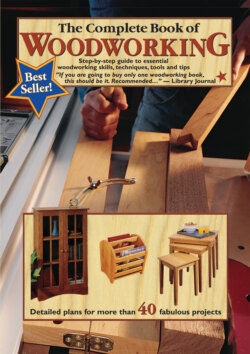Читать книгу Draw Manga - Tom Carpenter - Страница 26
Hardwood Lumber Sizes
ОглавлениеWhile nominal dimensions are widely used for selling softwoods, some retailers have extended the practice to hardwood boards as well. Your local home center probably stocks a few species of hardwoods, like oak, maple and cherry. These boards generally are planed to ¾ in. thick, jointed flat on the edges and cut to standard widths and lengths. Within the lumber industry, lumber of this sort is categorized as “S4S”, which stands for Surfaced Four Sides. All of this surface preparation at the mill translates to higher prices for you, but it may make the most sense to buy S4S lumber if you don’t own a thickness planer or jointer to prepare board surfaces yourself.
To find specialty or thicker hardwoods, you’ll need to shop at a traditional lumberyard. A good lumberyard will offer a wide selection of hardwoods in random widths and in an assortment of thicknesses and grades (See Hardwood Lumber Grades, below). In addition to S4S, you’ll find S2S lumber (planed smooth on two faces but the edges are rough), and roughsawn boards that are simply cut from the log, dried and shipped to the lumberyard.
Because of their diverse uses, hardwoods are offered in a much larger variety of thicknesses than standard 1x and 2x softwoods. This has led to the quartering system for determining lumber thickness, which allows you to buy hardwoods in ¼-in. thickness increments from ¼ in. on up. Most yards offer popular hardwood species in three, four, five, six, eight, ten and even twelve quarter thicknesses (which read as ¾, 4/4, 5/4, 6/4, 8/4, 10/4 and 12/4 on the label at the rack). These correspond to rough (pre-planed) thicknesses of ¾ in., 1 in., 1¼ in., 1½ in., 2 in., 2½ in. and 3 in.
HARDWOOD LUMBER GRADES
Hardwood lumber is graded using a different classification system than softwoods. Grades are based on the percentage of clear face cuts that can be made around a board’s defects (knots, splits, pitch pockets, and so forth. From highest grade (clearest) to lowest (most allowable defects), the grades are:
| Grade | Percentage of clear cuts |
| FAS (Firsts & Seconds) | 83⅓% |
| Select | 83⅓% |
| No. 1 Common | 66⅔% |
| No. 2A & 2B Common | 50% |
| No. 3A Common | 33⅓% |
| No. 3B Common | 25% |
Choose the lumber grade that best suits the needs of your project parts and your budget. It could be that a Common grade will provide all the knot-free lumber you need at a significant savings over FAS.
Hardwood surfacing options: If the extent of your hardwood needs amounts to only an occasional project, buy S4S boards at the yard. They’ll come planed on both faces and jointed flat on both edges, ready for cutting into project parts. If you have access to a jointer, consider buying S2S lumber, which still has rough edges but the faces are planed smooth. The most economical hardwood comes roughsawn to the lumberyard and will require you to do all of the surface preparation yourself. Some lumberyards will plane your stock for a nominal fee, if you don’t own a planer.
CALCULATING BOARD FEET
Hardwood lumber is sold at most lumberyards by the board foot, which can make calculating the amount of lumber you need a little confusing. The three boards below, for instance, all equal 2 board feet, though their physical dimensions are quite different. A board foot is actually 1/12 of a cubic foot of rough lumber, or 144 cubic inches. It is the equivalent of a piece of stock that is 12 in. wide, 12 in. long and 1 in. thick. But any combination of dimensions that multiplies to 144 is equivalent to one board foot.
To calculate the number of board feet a piece of lumber contains, its thickness times its width times its length (all in inches) then divide by 144. If one dimension is easier to calculate in feet rather than inches, divide by 12 instead. When calculating board feet, don’t forget to build some waste into the project estimate. The pros generally count on close to 30% when they’re buying S2S stock, and 40% with roughsawn lumber (mostly because they can’t see the defects until after planing).
Large retail lumber outlets and home centers make shopping for lumber easy. Most of the lumber you’ll find is fully surfaced and ready for building. Some larger home centers even stock lumber inside where it’s kept warm and dry. The downside to all of this convenience is that species options are limited, especially for hardwoods.
